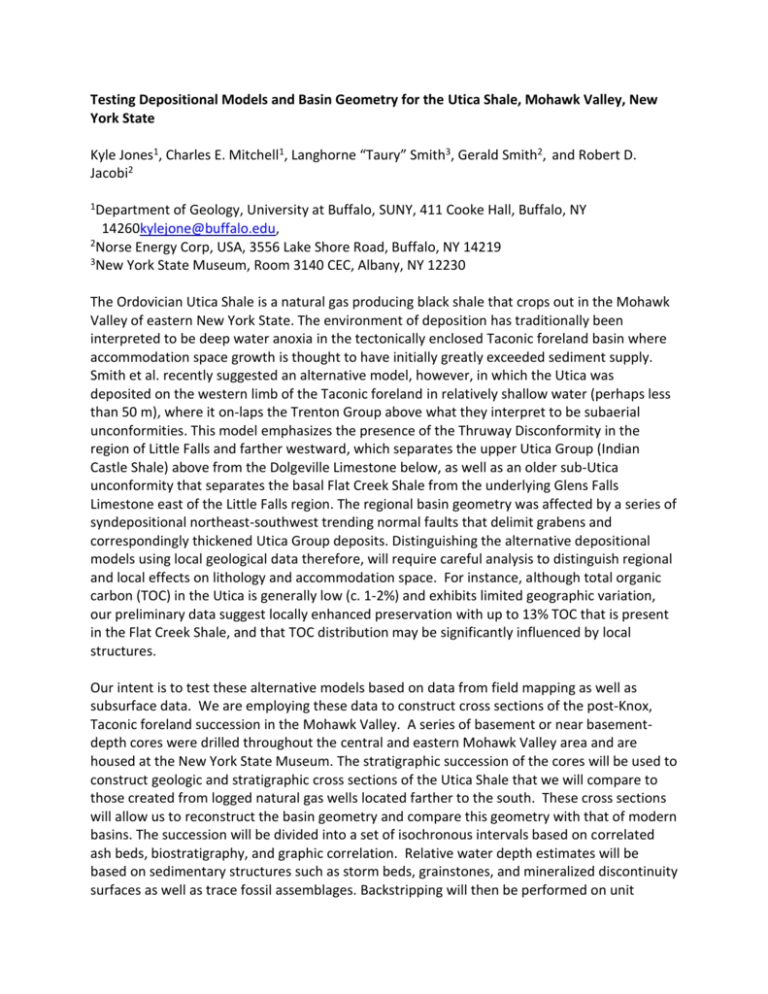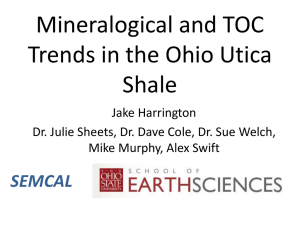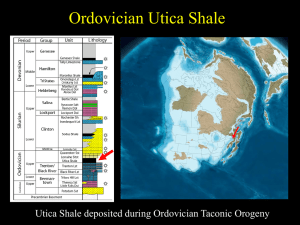Testing Depositional Models and Basin Geometry for the Utica
advertisement

Testing Depositional Models and Basin Geometry for the Utica Shale, Mohawk Valley, New York State Kyle Jones1, Charles E. Mitchell1, Langhorne “Taury” Smith3, Gerald Smith2, and Robert D. Jacobi2 1Department of Geology, University at Buffalo, SUNY, 411 Cooke Hall, Buffalo, NY 14260kylejone@buffalo.edu, 2Norse Energy Corp, USA, 3556 Lake Shore Road, Buffalo, NY 14219 3New York State Museum, Room 3140 CEC, Albany, NY 12230 The Ordovician Utica Shale is a natural gas producing black shale that crops out in the Mohawk Valley of eastern New York State. The environment of deposition has traditionally been interpreted to be deep water anoxia in the tectonically enclosed Taconic foreland basin where accommodation space growth is thought to have initially greatly exceeded sediment supply. Smith et al. recently suggested an alternative model, however, in which the Utica was deposited on the western limb of the Taconic foreland in relatively shallow water (perhaps less than 50 m), where it on-laps the Trenton Group above what they interpret to be subaerial unconformities. This model emphasizes the presence of the Thruway Disconformity in the region of Little Falls and farther westward, which separates the upper Utica Group (Indian Castle Shale) above from the Dolgeville Limestone below, as well as an older sub-Utica unconformity that separates the basal Flat Creek Shale from the underlying Glens Falls Limestone east of the Little Falls region. The regional basin geometry was affected by a series of syndepositional northeast-southwest trending normal faults that delimit grabens and correspondingly thickened Utica Group deposits. Distinguishing the alternative depositional models using local geological data therefore, will require careful analysis to distinguish regional and local effects on lithology and accommodation space. For instance, although total organic carbon (TOC) in the Utica is generally low (c. 1-2%) and exhibits limited geographic variation, our preliminary data suggest locally enhanced preservation with up to 13% TOC that is present in the Flat Creek Shale, and that TOC distribution may be significantly influenced by local structures. Our intent is to test these alternative models based on data from field mapping as well as subsurface data. We are employing these data to construct cross sections of the post-Knox, Taconic foreland succession in the Mohawk Valley. A series of basement or near basementdepth cores were drilled throughout the central and eastern Mohawk Valley area and are housed at the New York State Museum. The stratigraphic succession of the cores will be used to construct geologic and stratigraphic cross sections of the Utica Shale that we will compare to those created from logged natural gas wells located farther to the south. These cross sections will allow us to reconstruct the basin geometry and compare this geometry with that of modern basins. The succession will be divided into a set of isochronous intervals based on correlated ash beds, biostratigraphy, and graphic correlation. Relative water depth estimates will be based on sedimentary structures such as storm beds, grainstones, and mineralized discontinuity surfaces as well as trace fossil assemblages. Backstripping will then be performed on unit thicknesses derived from both well logs and measured core to constrain basin geometry and the history of accommodation space change at the time of deposition. Backstripping will also compare local subsidence to eustasy. The goal of this project is to predict zones of high TOC and to understand effects of basin evolution on deposition and preservation of black shales, ultimately resulting in greater natural gas production.




![Georgina Basin Factsheet [DOCX 1.4mb]](http://s3.studylib.net/store/data/006607361_1-8840af865700fceb4b28253415797ba7-300x300.png)






